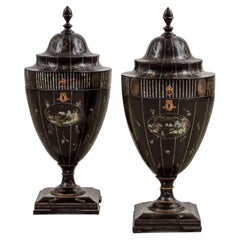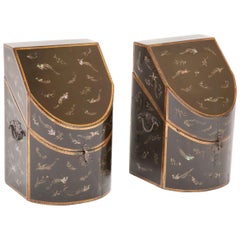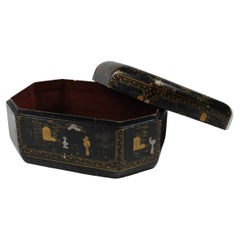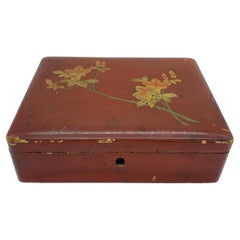Japanese Knife Boxes
3
to
2
1
3
3
3
1
2
3
2
2
1
1
12,777
119
49
35
30
Place of Origin: Japanese
Pair of Fine Japanese Export Lacquer Cutlery Knife Boxes, 18th Century
Located in Amsterdam, NL
A pair of fine Japanese export lacquered cutlery boxes
Kyoto or Nagasaki, late 18th century
H. 33.5 x W. 24 x D. 21 cm
The bow-fronted boxes with sloping lids flat at the top are made of hinoki wood (Cypress), coated with Japanese paper and decorated in lacquer with scattered gold birds and flowers on a nashiji background. The Japanese mounts are made of copper and both boxes still have internal partitions to keep the cutlery upright.
The form of these boxes is similar to a pictorial-style knife box in the collection of the Groninger Museum (inv. 1989- 347), dated between 1730 and 1780, but the style of the decoration is more like that on a knife box in the Peabody Essex Museum in Salem (inv. E62271), which was brought to Salem by James Devereux, Captain of the Franklin, in 1799.
Provenance:
Henriette Jeane Christine van Neukirchen, called Nyvenheim (1807- 1849) and Nicolaas Johan Steengracht van Oostcapelle (1806-1866), thence by descent to the last owners, Ludolphine Emilie baronesse Schimmelpenninck van der Oye (1944) married in 1969 to Roland Daniel van Haersma Buma (1944), the last residents of castle Duivenvoorden near Voorschoten and the great-great-granddaughter of Nicolaas Johan Steengracht van Oostcapelle.
There is no evidence that Nicolaas Johan himself, or any of his or his wife’s ancestors had ever been in Japan. However, Nicolaas’ grandfather (Nicolaas Steengracht, 1754-1840) was a director of both the VOC and WIC (West Indies Company...
Category
Late 18th Century Antique Japanese Knife Boxes
Materials
Silver
Pair of Japanese Lacquer and Mother-of-Pearl Inlaid Knife Urns, circa 1800-1815
Located in Amsterdam, NL
A rare pair of Kyoto-Nagasaki style lacquer and mother-of-pearl inlaid knife urns
Edo period, early 19th century
Measures: Height 71 x diameter 30 cm
?Formed as urns with vertically lifting covers and elongated finials, revealing fitted green velvet lined interiors for knives, decorated overall with birds, flowering stems, faux-fluting and oval panels with landscapes. The square plinth is raised on four bracket feet. Inside the lifting cover of one of the urns are Japanese characters, supposedly indications of some code by the craftsman.
A closely related knife urn, now in the collection of the Peabody Essex Museum, Salem (inv. E 73115), was acquired in Nagasaki by Captain Samuel Gardner Derby of the Margareth of Salem in 1801. Captain Gardner Derby traded in Nagasaki under charter from the VOC (Vereenigde Oostindische Compagnie), the Dutch East India Company. Between 1797 and 1814 Holland was occupied by the French and from 1811 until 1816 Java by
the English. During these periods practically no Dutch shipping was possible between Holland and Batavia (Jakarta) or between Batavia (Jakarta) and Nagasaki. To maintain a minimum amount of shipping between Batavia (Jakarta) and Nagasaki, between 1797 and 1807, the VOC chartered mainly American ships. American captains and officers ordered and bought mainly lacquered furniture in an American-English style, completely different from what the Dutch up till then had ordered. The present knife urns were possibly also ordered and acquired by Captain Gardner Derby during his stay in Deshima/Nagasaki in 1801.
Another similarly neoclassical shaped knife urn in the collection of the Ashmolean Museum Oxford (inv. 1996.17) appears to be signed by woodworker Kiyotomo koreo tsukuru (Kiyomoto made this). The same name, together with an address in the Sanjo-Teramachi District of Kyoto, has been found inside a fragmentary urn in a private collection. This is an indication that European-style furniture was not only lacquered in Japan but made there as well. This undoubtedly is not only true for knife-urns, but all European- style furniture lacquered in Japan after circa 1800 was made by Japanese furniture makers...
Category
Early 19th Century Anglo-Japanese Antique Japanese Knife Boxes
Materials
Brass
Rare pair of Japanese Nagasaki Export Lacquered Wood Knife Boxes
Located in Stamford, CT
Rare pair of Japanese Nagasaki Export lacquered wood knife boxes with mother-of-pearl inlay of flowers and birds, now converted to letter boxes. The boxes were converted to letter b...
Category
Early 19th Century Anglo-Japanese Antique Japanese Knife Boxes
Materials
Wood
Related Items
19th Century Lacquered Box Black Octogonal Chinese Export Gilded Floral
Located in Antwerpen, BE
Immerse yourself in the allure of the 19th century with our exquisite lacquered box, a stunning testament to Chinese export craftsmanship. Crafted in an elegant octagonal shape and a...
Category
Late 19th Century Chinese Export Antique Japanese Knife Boxes
Materials
Giltwood
H 5.71 in W 11.62 in D 8.08 in
Japan Red Lacquered Box 19th Century
Located in Beuzevillette, FR
Beautiful Japanese box in red lacquered wood. The lid is decorated with flowering magnolia branches and signed by the artist. The inside of the box is covered with a paint loaded wit...
Category
Late 19th Century Antique Japanese Knife Boxes
Materials
Wood
Pair of Large Antique Japanese Hokai Lacquer Boxes
Located in Atlanta, GA
A pair of Japanese lacquered lidded Hokai boxes with chased brass hardware and original ropes. Hokai boxes are traditionally used in Japan as the containers ...
Category
Early 20th Century Japonisme Japanese Knife Boxes
Materials
Wood, Lacquer
Japanese Lacquer Box with Fine Maki-e Decoration Meiji Period
Located in Atlanta, GA
A lacquered wood box with lid from Japan circa 19th century Meiji Period. The finely decorated box was used to store paper slips and small documents on the desk. It is overall finished with black lacquer (kuro) with sparse Mura-Nashiji effect outside and on the top surface of the lid, there are three Komainu, (sometimes known as Shishi or Japanese lions) frolicking and forming a circle in lively motion. Komainu are auspicious animals in Japanese cultures in both Shinto and Buddhism tradition. Originally from China, these animals symbolizes guardians to ward off evil spirits. Hiramaki-e was used in combination with carving and combing to render the lions with various surface textures. A gilt border with an slight angle was given to the lid and even the thin band is decorated with miniature floral scrolls. The interior of the box was finished in a dense nashiji. Underneath the lid, a cluster of peonies open lavishly by two gentle mounts. Takamaki-e (high relief) in both gold and silver were...
Category
Late 19th Century Japonisme Antique Japanese Knife Boxes
Materials
Wood, Lacquer
Japanese Lacquer Hokai Box, 19th Century
Located in Pasadena, CA
This is a good example of a traditional Japanese Hokai shell storage box for the Kai-awase game. This box is well-detailed in chased brass appliques and makie. The box is in overall ...
Category
Late 19th Century Japonisme Antique Japanese Knife Boxes
Materials
Wood, Lacquer
Japanese Maki-e Lacquer Document Box, Edo Period, early 19th Century, Japan
Located in Austin, TX
A spectacular Japanese maki-e lacquer lidded box, possibly a writing box, suzuribako, decorated with images of folding fans, ogi, Edo Period, earl...
Category
Early 19th Century Edo Antique Japanese Knife Boxes
Materials
Coral
Pair of Large Antique Japanese Hokai Lacquer Boxes
Located in Atlanta, GA
A pair of Japanese lacquer lidded Hokai boxes with chased brass hardware and original ropes. Hokai boxes are traditionally used in Japan to store and carry s...
Category
Early 20th Century Japonisme Japanese Knife Boxes
Materials
Wood, Lacquer
Japanese landscape pine kobako box Edo period 18th century
Located in PARIS, FR
Rectangular black and gold lacquer kobako box decorated with pine trees in a mountain landscape in takamaki-e, kirigane and hiramaki-e lacquer. Background in nashi-ji lacquer. Surmou...
Category
18th Century Antique Japanese Knife Boxes
Materials
Gold
German Stainless Steel Knife Fork Carving Set Mother of Pearl Handles, Set of 3
Located in New York, NY
A fine stainless steel German carving set with mother of pearl handles, from Carl Wolfertz & Sohne, circa 20th century, Solingen, Germany. Set includes carving knife, fork, and sharpening steel...
Category
20th Century Japanese Knife Boxes
Materials
Stainless Steel
H 0.75 in W 11.63 in D 1.5 in
Japanese Lacquer Box
Located in New York, NY
A Japanese red burgundy, gold and black lacquer box with round corners and silk cloth interior lining, circa early-20th century, 1920s, Japan. Box was desi...
Category
Early 20th Century Japanese Knife Boxes
Materials
Wood, Silk
Japanese Lacquer and Geometric Meiji Period Inlaid Tray
Located in Garnerville, NY
Japanese inlaid, lacquered and gilded tray. Possibly for the sacred tea ceremony. This tray has beautiful geometric inlays with a gilded edge and a bla...
Category
1890s Meiji Antique Japanese Knife Boxes
Materials
Wood, Fruitwood, Oak, Lacquer
Japan Red Lacquered Box 19th century
Located in Beuzevillette, FR
Beautiful Japanese box in red lacquered wood;
19th century
The lid is decorated with a landscape with a bird, trees and a setting sun.
The inside of the box is covered with a lacque...
Category
Late 20th Century Japanese Knife Boxes
Materials
Wood
Recently Viewed
View AllMore Ways To Browse
Vintage Wood Knife Holder
Vintage Bone Cutlery
Vintage Laguiole Knives
Vintage Ivory Cutlery
Antique Kitchen Choppers
Jean Dubost
Vintage Laguiole Steak Knives
Laguiole Steak Knives
Vintage Ivory Cutlery Set
Chinese Trousse
Magnetic Knife Holder
Spong Knife Sharpener
Louis Xvi Ebonized Cabinet
Antique Mahogany Bureau Desk
English Walnut Side Cabinets
Pair Antique Glass Doors
Gothic Dining Set
Mid Century Modern Bedside Cabinet




